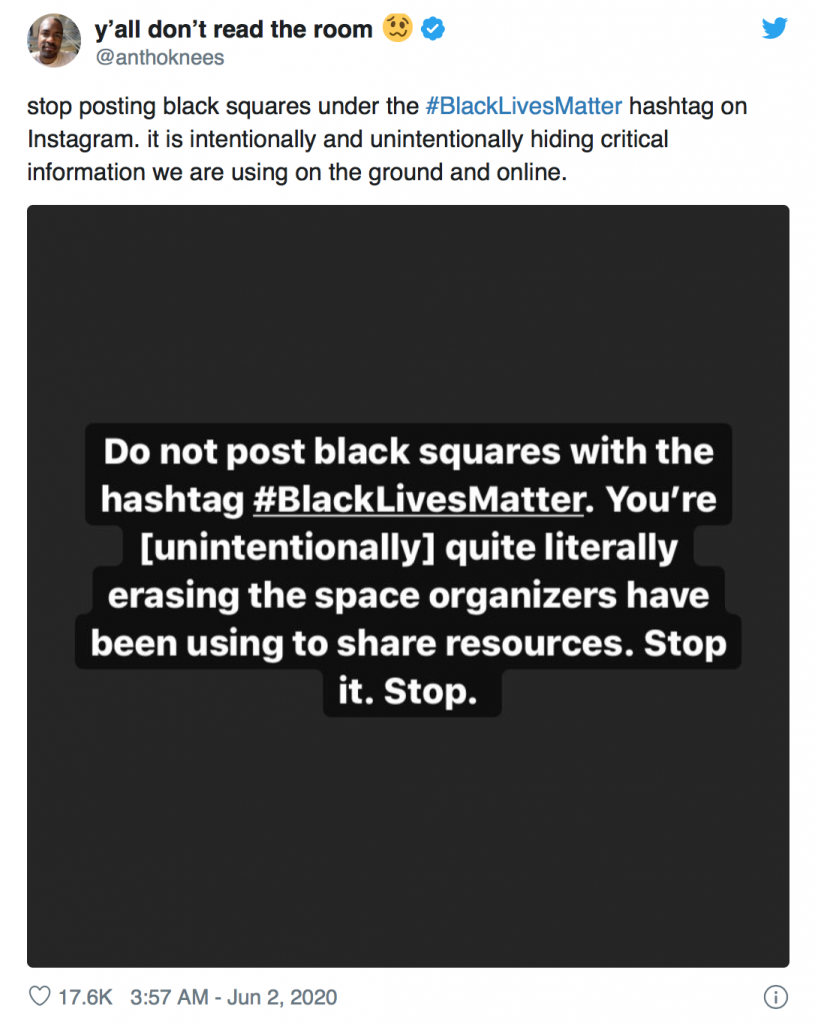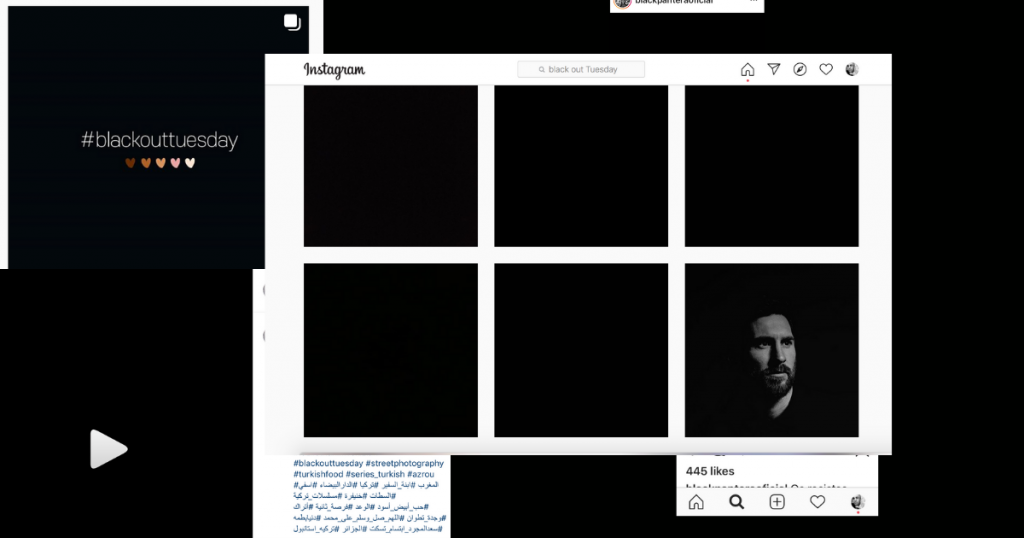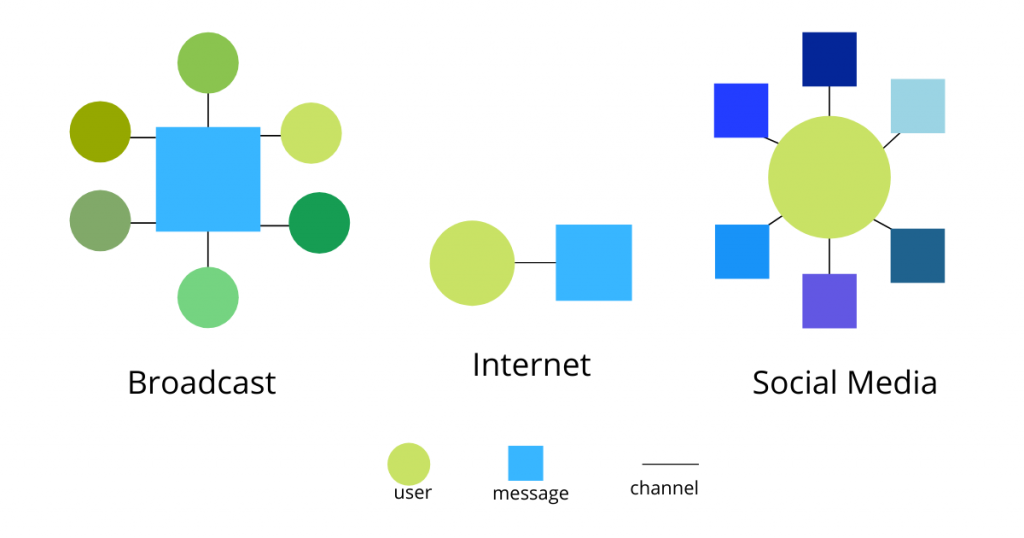Signal and Noise
During the BlackLivesMatter “Blackout Tuesday” protests last week, many of us saw the following admonition in our various social feeds and in the comment section of Instagram posts:

Why did these most earnest of social justice warriors want us to stop using #blacklivesmatter in our posts? Wasn’t solidarity and the spread of a movement the whole idea?
The Signal
When these concerned organizers saw their own feeds become clogged with one blacked-out image after another, they realized that their messaging was lost in a sea of black. Organizers, who ironically tried to police Blackout Tuesday, were being frustrated by both the nature of social participation and how Instagram works.
Instead of letting the protest form organically, these organizers wanted to disseminate specific messages and information using Instagram. To them, the critical thing was the signal. By focusing on their messaging, they missed the beauty of the noise. They began tamping down the participation they had encouraged. The “don’t use #blacklivesmatter” scolds started trending and became one of the predominate messages of the day. I think the simple blacked-out screen shot was more artful and positively impactful.

The Noise
What the organizers perceived as noise was, in fact, the most important thing—participation. Blackout Tuesday was a success because it got millions of people to express themselves on behalf of an issue when they might otherwise have stayed silent.
When we participle in any social media campaign, we incrementally move from being spectators to stakeholders. This shift is gold to companies who spend millions on influencer marketing, interactive media and direct response advertising. Converting a passive consumer to a co-creator for any brand is a major step in creating lasting brand loyalty.
No individual post listing real injustices, “important” Netflix docs, or local meet-up times is as important to the success of the movement as having millions of people do something, even something as seemingly insignificant as posting a black screenshot. Each of those little blacked-out posts represents buy in from a fellow citizen and voter. Marketing gold.
The Platform
Why wasn’t Instagram effective for disseminating information in the way conceived by Blackout Tuesday organizers? The easy answer is always the algorithm; that mysterious artificial intelligence that determines who, what, when and where a post is displayed on Instagram or any social media platform.
The algorithm is easy to blame, but hard to understand. Actually, it’s impossible to understand because it’s always changing. First, the algorithm’s output is always changing due to exigent conditions on the platform—like millions of black screen shots using #blacklivesmatter. And secondly, social media platforms are constantly tweaking their algorithms to make the user experience better and to increase ad revenue.
Probably the easiest way to understand why the algorithm is a necessary evil is to consider your own social media feed. First, look at the size of the feed space. Depending on your device (Instagram is a mobile phone app), you’ll see one or two posts at once. Interaction is limited to that space and by how much time you spend scrolling and interacting with each post.
Let’s say you follow 500 people, brands and hashtags. If half of those post every day, it will take some time to get through all of those posts and stories, especially when you factor in the fact that the rate of ads in your feed might be 1:3 in prime viewing times. So, how many of those 250 posts do you actually interact with every day?
You may think your posts reach all of your followers. They don’t. If you don’t interact much with your followers, the algorithm pushes your post down the queue, behind that follower’s more relevant interactions and behind paid content. And as time goes by, your post becomes less relevant. Even when you make it into your follower’s feed, if they don’t look at your post in a timely manner, it slips further and further down their feed.
Consider the millions of users and companies vying for space in your feed and you’ll get a picture of how ineffective Instagram is at timely messaging. Instagram is better for branding and low-touch interaction with user-generated content. Other platforms, like Facebook and Twitter, can be more effective dissemination tools due to certain affordances like groups, direct messaging and content structure. But they also are limited by algorithmic control over the vast torrent of content generated each second.
Complementary Media
Many try to use social media as a broadcast medium without recognizing how the media shapes the message. Consider the following simple diagram explaining user relationships to the messages via different media. For the user, social media is not like watching a single television channel, or connecting to a website. It’s like having 500 channels streaming in all at once.

Social media is a complementary media. The most effective strategy for social media–based information dissemination is to use social media to draw users to an information rich website. There, users can engage with your messages and information and action strategies. They can also up their commitment by signing up for future email, texts and other vital updates from your organization.
As in all communication, the media matters. Understanding the limits of social media will help you determine how it fits into your quiver of options. While I can help with ways to think about and use social media, I can’t help turn it into something it’s not. For that, you’ll need to sign up for my $5,000 a month newsletter. LOL
